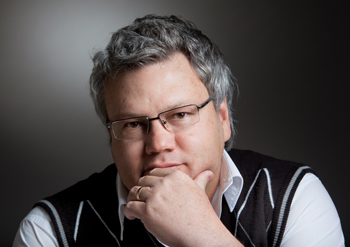
Prof Hendrik Swart
Photo: Merwelene van der Merwe |
Since his appointment as the South African Research Chairs Initiative (SARChI) Chair, there has been a sharp increase in the number of papers and publications by Prof Hendrik Swart, Senior Professor in the Department of Physics at the University of the Free State (UFS). From January this year, he has already published 78 articles. Some of the journals that has published his work, includes:
• Nanotechnology (impact of 3.67)
• Dalton Transactions (impact of 4.097)
• Sensors and Actuators B: Chemical (impact 3.84)
“My biggest success, however, is the powerful group of researchers we have built over the years. Staff, postdocs and students – without them it would have been impossible. I am therefore much indebted to my groups on both the Bloemfontein and Qwaqwa Campuses.
“The good apparatus we acquired via a sponsorship from the National Research Foundation and Sasol is also one of the main reasons for this. The financial support I get from the university’s research office is of course also a contributing factor,” he says.
For the past 20 years, Prof Swart has been conducting research on any substance that glows. “I only adjust the focus to fit in with current trends,” he says.
Prof Swart believes that his research will make a contribution to the fundamental knowledge about phosphors, as well as to the training of good students for the academic and industrial world on the outside. For the man on the street, his research translates into better, brighter lights that use less energy.
His more recent research focuses on the development of nano-phosphors for light-emitting diodes (LEDS) and organic light-emitting diodes (OLED).
Prof Swart has presented papers on his research not only nationally, but all over the world – including countries in Europe and the East. Some of the most recent papers presented by him and his colleagues/postgraduate students include:
• Applications of AES, XPS and TOF SIMS to phosphor materials at die 15th European Conference on Applications of Surface and Interface Analysis 2013 in Forte Village Resort, Sardinia, Italy.
• Luminescent properties of phosphor nano thin films at the first International Symposium on Nanoparticles/Nanomaterials and Applications in Caparica (Lisbon, Portugal), where he was an invited speaker.
• Role of surface and deep-level defects on the emission of nano metal oxides at the 2014 NanoAfrica international conference, Vanderbijlpark, South Africa, where he delivered the keynote address.
• PHI systems and their modifications at KOVSIES at the PHI European User Meeting in Ismaning (Munich), Germany, where he was invited to speak.
Prof Swart also delivered the keynote address at the SETCOR International Conference on Smart Materials and Surfaces in Bangkok, Thailand. His lecture was titled, ‘Role of surface and deep-level defects on the emission and degradation of phosphor materials’.